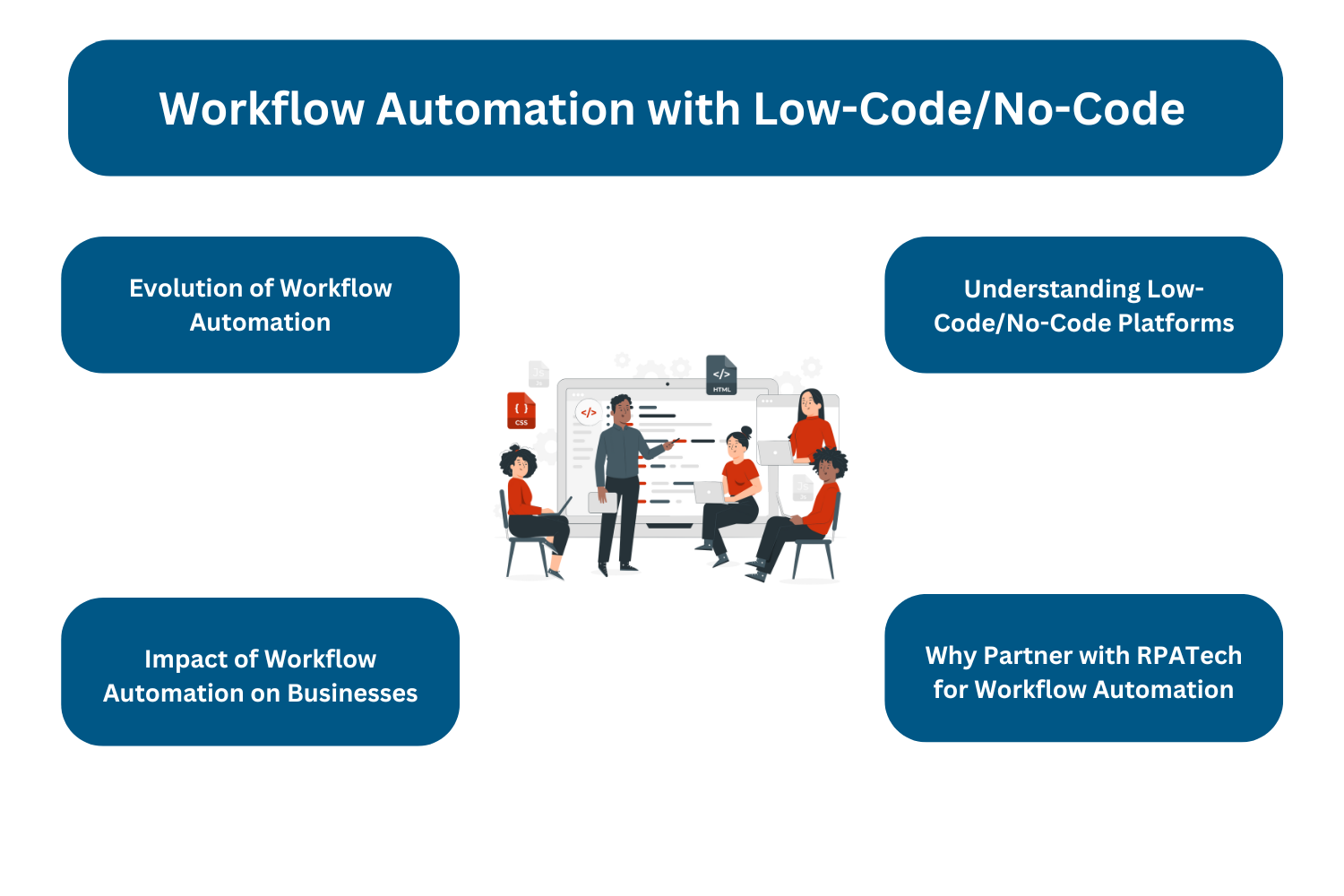In today’s fast-paced business environment, efficiency and agility are paramount. Companies are constantly seeking ways to streamline their operations and enhance productivity. This is where workflow automation comes into play, transforming repetitive, manual processes into automated, efficient workflows. With the advent of Low-Code/No-Code platforms, businesses can automate workflows within few days or weeks that earlier required coding, consuming months.
In this blog post, we aim to understand:
- What is workflow automation?
- The Evolution of Workflow Automation
- Understanding low-code/no-code
- The Impact of Workflow Automation on Businesses
- Key Considerations for Implementing Workflow Automation
- Why Partner with RPATech for Workflow Automation
What is Workflow Automation?

Workflow automation refers to the design, execution, and automation of processes where tasks, documents, and information are passed from one employee to another for action, according to a set of procedural rules. By automating workflows, businesses can ensure tasks are completed consistently and efficiently, reducing the time spent on manual processes and minimizing errors. Common examples of workflows that can be automated include approval processes, data entry, and customer support.
The Evolution of Workflow Automation
Historically, workflow automation was heavily reliant on traditional programming. IT departments had to build custom solutions from scratch, requiring significant time and resources. However, as technology evolved, so did the tools available for automation. The introduction of Low-Code/No-Code platforms marked a significant shift, democratizing the ability to create and manage automated workflows. These platforms provide a visual, user-friendly interface that allows even those with limited technical skills to design, implement, and modify workflows quickly and efficiently.
Understanding Low-Code/No-Code Platforms
What are Low-Code/No-Code Platforms?
Low-Code/No-Code platforms are software solutions that allow businesses to custom build workflow automation, thereby significantly reducing the complexity and time required for application development. These platforms enable businesses to create workflow automation within a few days or weeks, as opposed to several months. This significantly increase efficiency, reduce costs, and ultimately enhance the competitiveness of the business.
Benefits of Low-Code/No-Code Platforms
- Speed: Rapid development and deployment capabilities allow businesses to automate processes quickly, adapting to changing needs.
- Cost-Effectiveness: By minimizing the need for extensive coding and IT resources, companies can save on development costs.
- Flexibility: Workflows can be easily adapted and scaled as business requirements evolve.
The Impact of Workflow Automation on Businesses
Transforming Business Processes
Workflow automation has the potential to revolutionize business operations. For instance, automated approval processes ensure that documents are reviewed and approved promptly, reducing delays. Automated data entry eliminates human errors and speeds up data processing. Case studies have shown significant time savings, error reduction, and productivity increases. Additionally, automated workflows enhance compliance and governance by ensuring that all steps are followed consistently.
Industries Benefiting from Workflow Automation
Various sectors are reaping the benefits of workflow automation. In healthcare, automated patient intake processes improve efficiency and reduce waiting times. Financial institutions use automation to streamline loan processing and regulatory compliance. Manufacturing companies automate inventory management and supply chain processes, while HR departments leverage automation for onboarding and payroll management. Each industry has unique challenges, but workflow automation provides tailored solutions to address them effectively.
Key Considerations for Implementing Workflow Automation
Identifying Automation Opportunities
The first step in implementing workflow automation is identifying processes that can be automated. Start by assessing your current workflows and pinpointing repetitive, manual tasks that consume significant time and resources. Prioritize these workflows based on their impact and feasibility for automation.
Overcoming Common Challenges
Implementing workflow automation can present challenges, such as resistance to change within the organization. To address this, involve stakeholders from the beginning and communicate the benefits clearly. Ensuring data security and privacy is crucial, especially when automating processes involving sensitive information. Integration with existing systems and tools is another consideration, requiring careful planning and execution.
Why Partner with RPATech for Workflow Automation
RPATech’s Expertise in Automation
RPATech is a leader in the automation industry, with extensive experience in deploying successful automation solutions across various sectors. Our team has deep expertise in Low-Code/No-Code platforms, enabling us to deliver customized automation solutions that meet your specific needs.
At RPATech, we adopt a consultative approach, taking the time to understand your business goals and challenges. We tailor our solutions to align with your objectives, ensuring a seamless integration with your existing systems.
Conclusion
The landscape of workflow automation is continuously evolving, with emerging technologies like artificial intelligence and machine learning set to enhance automation capabilities further. Staying ahead of these trends will be crucial for businesses aiming to maintain a competitive edge.
Automate Your Workflows Within a Few Days or Weeks
Say goodbye to spending months on developing workflow automation through traditional programming. Now, you can go live with your workflow automation in just a few days or weeks. Click to find out how!




